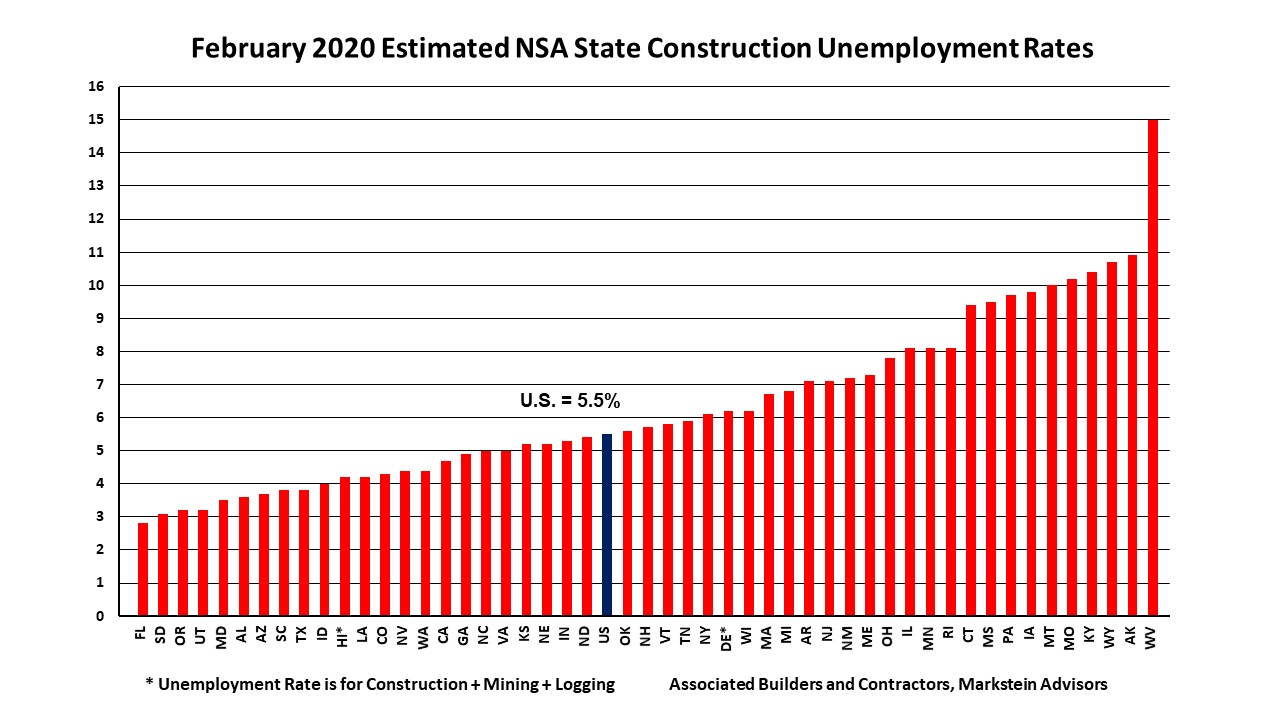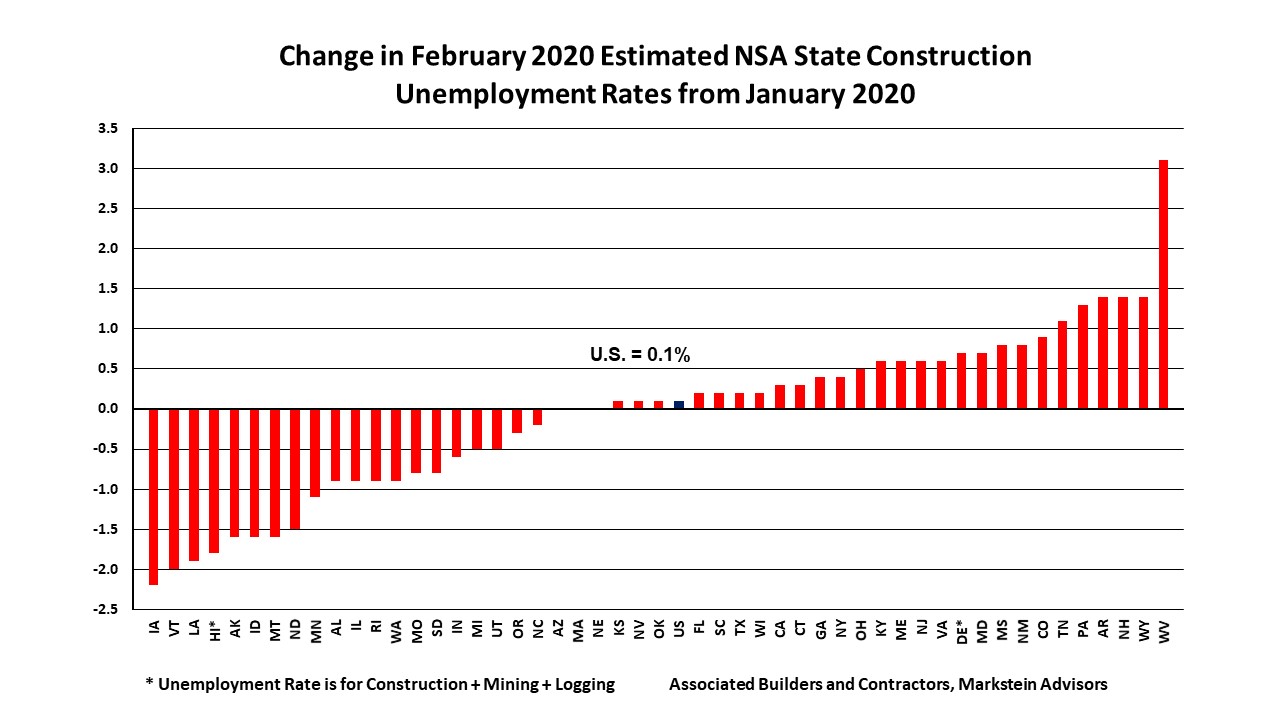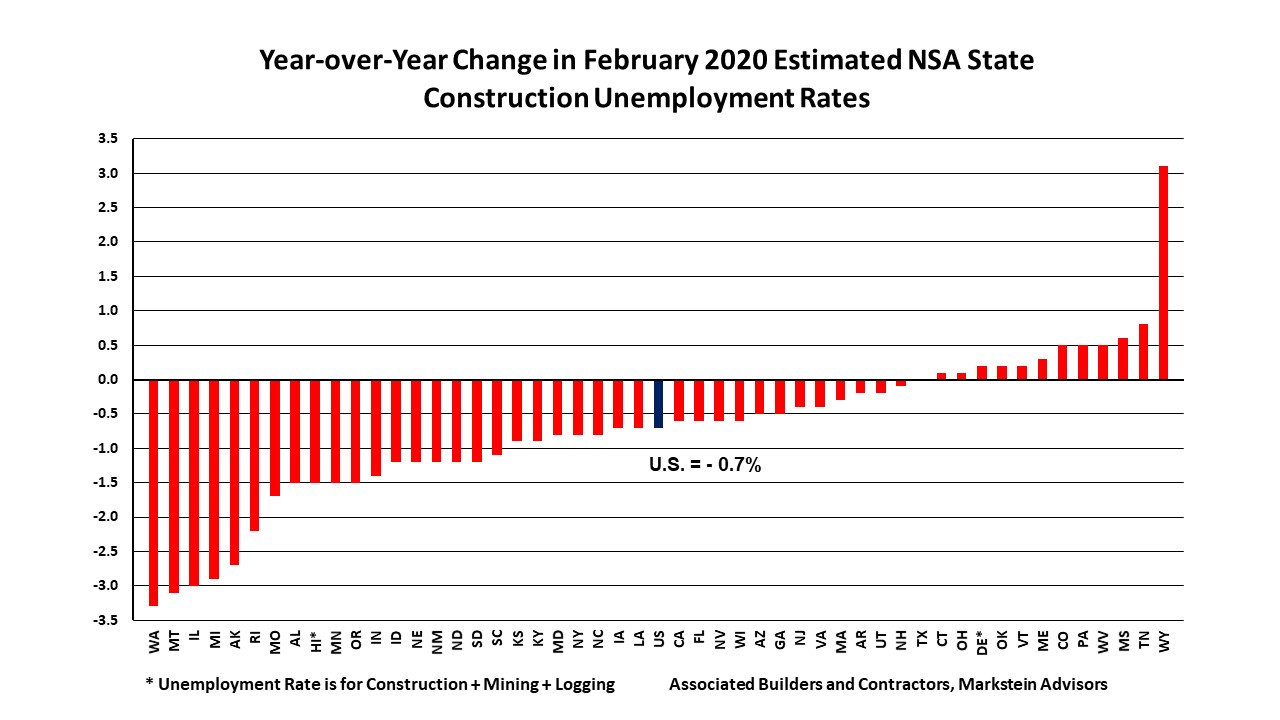February Construction Unemployment Rates Down in 37 States Year Over Year, Says ABC
WASHINGTON, April 8—Estimated February not seasonally adjusted construction unemployment rates fell nationally and in 37 states, rose in 12 states and were unchanged in one state (Texas) on a year-over-year basis, according to an analysis of U.S. Bureau of Labor Statistics data released today by Associated Builders and Contractors.
As of February 2020, the construction industry employed 208,000 more workers nationally compared to February 2019 while the national NSA construction unemployment rate decreased from 6.2% to 5.5% over the same period, according to BLS numbers. This is an indication of the underlying strength of the construction industry prior to widespread concern over the impact of the coronavirus and reaction to it in the United States.
“In February, large portions of the country experienced above-average temperatures. The Eastern third of the country, along with the northern tier of states and the West Coast, had warmer than normal weather. This aided construction activity and employment,” said Bernard M. Markstein, Ph.D., president and chief economist of Markstein Advisors, who conducted the analysis for ABC. “These numbers were collected before actions were taken by many localities and businesses to control the spread of COVID-19 in the United States. These efforts to limit the impact of the coronavirus on the health of the nation and consequently on construction activity will begin to show in the data for March and April and beyond.
“March national employment and unemployment figures released on Friday, April 3, along with the recent surge in unemployment insurance claims, indicate a large impact on the economy. The March employment and unemployment data were collected before many places issued stay-at-home recommendations. However, growing concern over the spread of the disease was adversely affecting employment. The NSA construction unemployment rate jumped from 5.5% in February to 6.9% in March, only the third time in the history of this number that it rose from February.”
Because these industry-specific rates are not seasonally adjusted, national and state-level unemployment rates are best evaluated on a year-over-year basis. The monthly movement of rates still provides some information, although extra care must be used when drawing conclusions from these variations.
The national NSA construction unemployment rate increased 0.1% from January to February. Over the time since the data series began in 2000, the historical pattern generally has been an increase in rates from January with 12 increases, seven decreases and once unchanged. Among the states, 27 had higher estimated construction unemployment rates than in January, while 20 were lower and three were unchanged. At the same time, the nation and 23 states posted their lowest February construction unemployment rate on record.
The Top Five States
The states with the lowest estimated NSA construction unemployment rates in order from lowest to highest were:
1. Florida, 2.8%
2. South Dakota, 3.1%
3. Oregon and Utah (tie), 3.2%
5. Maryland, 3.5%
Three of these states—Florida, Maryland and Oregon—were in the top five in January. For the third consecutive month, Florida had the lowest construction unemployment rate among the states. This was also the state’s lowest February rate on record.
South Dakota had the second lowest rate in February, up from ninth lowest in January. This was the state’s lowest February rate on record.
Oregon and Utah tied for the third lowest rate in February. For Oregon, this was up from fourth lowest rate in January based on revised data (originally reported as tied with Utah for fifth lowest). It was also Oregon’s lowest February rate on record. For Utah, this was up from the seventh lowest rate in January, tied with Arizona, based on revised data (originally reported as tied with Oregon for fifth lowest). This was Utah’s lowest February rate since the 2.3% rate in 2015.
Maryland had the fifth lowest rate in February, down from second lowest in January. Nevertheless, this was the state’s lowest February rate on record.
Colorado, which was third lowest in January, dropped to 13th lowest in February with a 4.3% rate. After reaching 3.8% in February 2019, it was the state’s lowest February rate since posting a 4.2% rate in 2000, making it the third lowest February rate on record for the state.
South Carolina and Texas, which tied for fifth lowest rate in January based on revised data (originally reported as third lowest for South Carolina, tied with Colorado, and seventh lowest for Texas, tied with Arizona), tied for eighth lowest in February with a 3.8% rate. For both states, it was their lowest February rate on record.
The Bottom Five States
The states with the highest estimated NSA construction unemployment rates in order from lowest to highest were:
46. Missouri, 10.2%
47. Kentucky, 10.4%
48. Wyoming, 10.7%
49. Alaska, 10.9%
50. West Virginia, 15%
Three of these states—Alaska, Missouri and West Virginia—were also in the bottom five in January. West Virginia had the highest estimated construction unemployment rate in February, compared to third highest in January. After the 14.5% rate in February 2019, this was the state’s lowest February rate since the 14% rate in 2013. West Virginia also had the largest monthly increase in its rate among the states, up 3.1%.
Alaska had the second highest rate in February compared to highest in January. Nonetheless, this was the state’s lowest February rate on record.
Wyoming had the third highest rate in February compared to seventh highest in January. Wyoming had the largest year-over-year increase in its rate among the states, up 3.1%.
Kentucky had the fourth highest rate in February compared to sixth highest in January. This was Kentucky’s second lowest February rate on record, behind the 10.3% rate in 2006.
For the second month in a row, Missouri had the fifth highest rate in February. This was the state’s lowest February rate since the 9.5% rate in 2016.
Iowa, which had the second highest rate in January, had the seventh highest in February with a 9.8% rate.
Montana, which had the fourth highest rate in January based on revised data (originally reported as third highest, tied with West Virginia), had the sixth highest in February with a 10% rate. This was the state’s second lowest February rate on record, behind the 6.7% rate in 2007. Montana had the second largest year-over-year drop in its rate among the states, down 3.1%, behind Washington state’s 3.3% decrease.



To better understand the basis for calculating unemployment rates and what they measure, see the article Background on State Construction Unemployment Rates